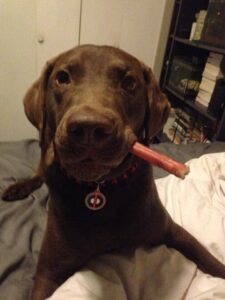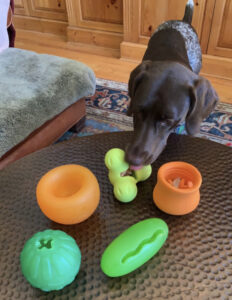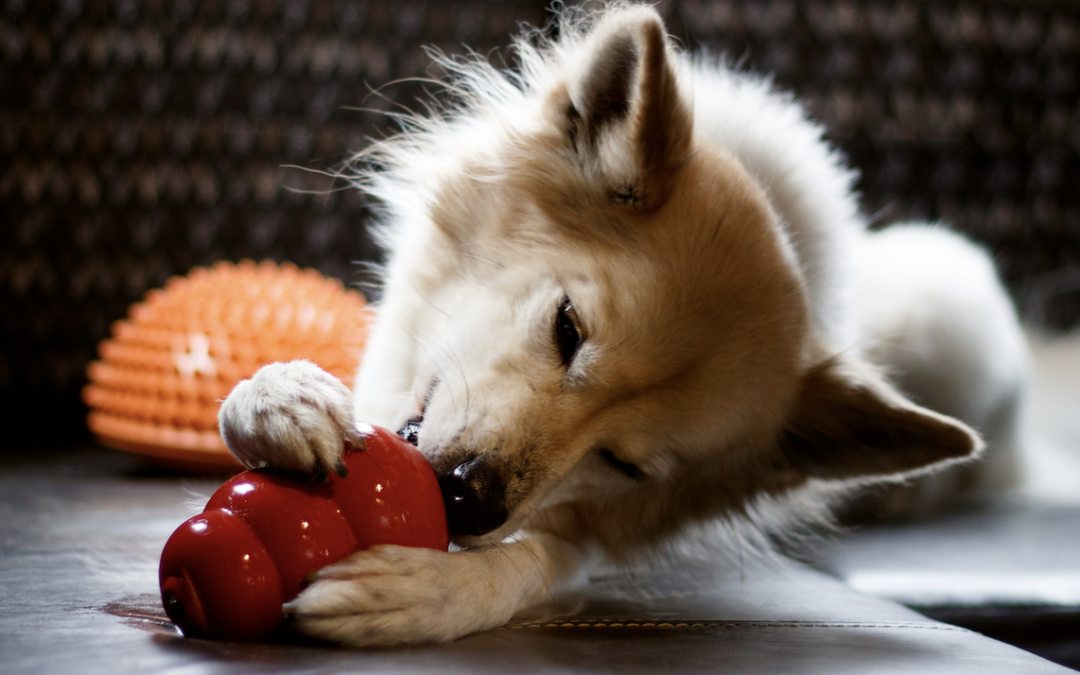“Canine enrichment” is a popular buzzword that’s been sweeping the dog training world more and more for the past few years. But what is enrichment really, and how can it benefit your dog?
“Enrichment” is defined as “the action of improving or enhancing the quality or value of something.” Ok, so then enrichment in the animal sense essentially means “improving the lives of animals.”
My first encounter with enrichment came when I was a bright eyed eager kid at Zoo Camp at the Oakland Zoo. I watched and helped as peanuts, lettuce, and fruit was hidden around the elephant enclosure (with one elephant “hiding” behind a tree so she could see where everything was hidden), and as the tigers shredded cardboard boxes with raw meat and tossed around jolly balls with glee. Wild animals in captivity, unless enriched, often turn to things like habitat destruction, self mutilation, and obsessive behaviors. By introducing elements of natural behaviors like foraging, shredding, and problem solving, a lot of the behaviors that the zoo animals were exhibiting went away without being directly addressed.
On the front of domesticated animals (dogs, cats, rats, etc.), when I see things happening like dogs digging in the yard, destroying furniture or shoes, barking for “no reason,” and other nuisance behaviors, I first look at their daily enrichment. For many dogs, the extent of their daily enrichment is a walk around the neighborhood. While walks can be enriching, if your dog is super revved up and frantically excited for all or most of the time (releasing adrenaline and cortisol), then you may be getting the opposite of a satisfied, enriched dog by the time they wake up from their post-walk crash nap. Does that mean walks are bad? No. But definitely tailor your exercise and enrichment routine to YOUR dog rather than going on long walks because “that’s what you’re supposed to do.” (According to who?)
Types of enrichment
I break enrichment into a few categories, with food and scent being my primary motivators. Let’s talk about food first. There’s a movement within the enrichment movement (movement-caption?) called Ditch The Bowl, which encourages owners to feed their dogs through other means than a plain ol’ food bowl. While I strive to use as much of my dogs’ meals for training and enrichment as I can, I’m not perfect and sometimes I do still feed from a bowl, but I do use slow-feeder bowls so that I at least give my dogs a bit of a challenge on the “boring” days.

Uli works on finding treats out of a snuffle mat
Brain toys
I categorize brain toys as “toys that require manipulation on the dog’s part to get food to come out.” Some of the brain toys I love are:
- Orbee Tuff Snoop: this toy comes in two sizes, making it a good option for pretty much all sizes of dog. It holds a pretty good amount of food, and is made of a rubbery material which means that it’s quiet on hard floors. I love that this toy can be flipped inside out to make it easier for novice dogs, and then put back to normal once those dogs get a bit more talented at problem solving.
- Bob-a-lot: this toy also comes in two sizes and is made of pretty durable hard plastic. It doesn’t hold very much food so it does need to be refilled a few times, but it has two sliders where you can adjust the level of difficulty, which I think is an awesome feature.
- Snuffle mat: these mats are made with strips of fleece fabric or other material. Kibble or treats can be scattered on top (easy) or tucked between the strips (harder) to encourage natural sniffing and snuffling. As sniffing is a calming behavior (think meditation or deep breathing for humans), I really like these mats for excitable or easily overstimulated dogs.
- Slow feed bowls: these are my “cheater” brain toys for when I want to be able to just quickly dump some food out and go. They come in tons of designs which I really like. If you want them to take a bit of extra time or make them more exciting, you can take some of the treat dust at the bottom of your treat pouch or at the end of a bag of treats and sprinkle it in the crevices.

Charles the Chesapeake Bay Retriever holds a bully stick
Chews
These are edible, long lasting treats that you can give your dog to allow them to relax, work their jaw, and burn off some mental energy. Always make sure to supervise your pup the first few times you give them a chew to make sure they aren’t going to swallow it whole and/or choke, and make sure to size your chew appropriately to the size of your dog.
- Bully sticks: these tend to be my favorite go-to. They’re single ingredient (dried beef penis), not too fatty, and last a decently long time if you get thick ones (for my dogs that means one 12” thick bully stick lasts about an hour). They can be a bit stinky, but they do also make a lower odor variety if smell is a big deal.
- Himalayan yak chews: made with just yak’s milk and a bit of lime juice to help it curdle and harden, this is another one of my favorite low ingredient number chews. They last a long time, even for power chewers, and have a pretty pleasant smell.
- No-hides: these are a great alternative to rawhide (which is not safe/healthy), and come in several flavors and sizes. These last about as long as a thick bully stick for my dogs, so the 7” no hide lasts about 1 hour.
- Tracheas: they come in multiple protein (beef, lamb, etc) sources which makes them a good option for dogs with allergies. These can be chewed as-is or stuffed… read along in the next section for ideas on stuffing!

Mika the German Shorthaired Pointer chooses from a variety of brain toys and stuffables
Stuffables
Toys and chews that you can stuff food into, aka stuffables, are one of the most flexible types of food enrichment. I’m going to make two lists for this category: stuffable toys and stuff to stuff em with! With dogs who are new to stuffable toys I make them pretty easy (wet or dry foods, not frozen), but with more experienced pups I’ll freeze them to make them last longer.
Toys:
- Kong: Probably the most iconic stuffable toy, Kongs have been big on the scene for years.
- West Paw Toppl: the open shape of this makes them a little easier to get to for many dogs than classic Kongs, which can be a good thing or a bad thing! I like that these hold a bit more food so I’ll sometimes use them as a meal replacement for my dogs.
- West Paw Tux: these are amazing for power chewers.
- Water buffalo horn: this is both a chew and a stuffable!
- Cow hooves: very cheap, very stinky, and a big hit in my house. This is another item that’s both a chew and a stuffable.
Stuffing:
- Canned dog food: I like pate style canned foods mixed with a bit of water to make them easier to “slop” into the stuffable toy. Brands I like are Fromm, Nulo, and Koha.
- Dehydrated dog food: Dehydrated food is nice because you can add as much or as little water as you want to get it to the perfect consistency. I’ll often make it a bit runny and then mix in kibble – the dehydrated food acts like glue and the kibble bulks it up and makes it go a bit further. I use either The Honest Kitchen or Grandma Lucy’s brands.
- Ground raw: raw food amazing for dogs! You can either use balanced commercial raw from a pet store or online, or you can use ground meat from the grocery store. If you’re using ground meat from the grocery store, make sure that the rest of your dog’s diet is appropriately nutritionally balanced. The brands I like for premade are Answers, Small Batch, Eco Pawz, and Darwin’s.
- Plain yogurt: greek or regular both work, I use this to add some probiotics to my dogs’ diets.
- Canned pumpkin: make sure to get 100% pumpkin, not pumpkin pie filling. This is great for settling upset tummies.
- Treat “dust”: do you have extra crumbs at the bottom of your treat bag that you’re about to throw out? WAIT! Sprinkle that magic dust in between layers as you stuff toys. Your dog will thank you!
Food enrichment and weight management
With all these extra food toys, chews, and stuffables, won’t dogs on an enrichment plan become balloons? Yes, but only if their diet is not correctly adjusted. If you are increasing the amount of food that your dog is getting via enrichment, decrease the amount of food they get through regular meals. Remember, this is in part a way to make meals more enriching instead of just eating from a bowl, it’s not meant to just add extra calories to your dog’s day. Some things, like tracheas, tend to be extra fatty, so if you have a dog who struggles with weight then give those as a more occasional treat. You can also mix fruits and vegetables like apples and carrots in with your stuffable mixture, making the more fattening stuff like canned dog food stretch out a bit further.
Scent enrichment
While humans rely on vision as our primary sense, dogs are primarily scent driven, with senses of smell that are 20-40 times greater than ours. We as owners can harness that sense of smell and use it to our advantage to tire our dogs out in a satisfying way. Some examples of using scent-based enrichment are below.
- Treat searches: put your dog in another room (or if you want to be fancy, in an out of sight stay) and hide some treats around a room. I teach my dogs that food on surfaces is off limits so I only hide food around the floor (up against or slightly behind furniture, under discarded toys, or in corners), but if you don’t mind your dog learning to look higher then you can get even more creative. If you have a counter-surfer and you’d like to fix that behavior, then teaching him to check the floor for snacks and that nothing will ever be found on counters during searches can provide some very useful reinforcement for appropriate floor sniffing behavior!
- Scatters in grass: scattering kibble or treats in grass is like nature’s snuffle mat. It’s awesome! I do this a lot when I’m out and about and my dogs need a bit of help calming down.
- Nosework: this is a sport based on teaching dogs to find target odors, usually birch, anise, and clove. If you are interested in trying this out with your dog, I encourage you to find an in-person or online class (or reach out to me for private training).
- Sniffaris/decompression walks: with your dog either off leash or on a long line and harness (I like 20-30 ft lines for this), take him to an interesting smelling area like a hiking trail or field where critters like to hang out. Let him sniff and follow him around. Don’t work on obedience other than a few rewards for checking in, this should be his time to sniff. I also avoid playing fetch on sniffaris, as fetch releases a lot of “excitement hormones” which create the opposite effect of a sniffari’s “relaxation” goal. If you have a very prey driven dog who gets overaroused or worked up by tracking or chasing critters when you try this, then find a more boring area like an empty baseball or soccer field. In terms of how long to go, I usually take the amount of time it takes my dogs to go from excited to calm, and then double that. For my dogs that’s usually around 45-60 mins.
Try out a few different types of enrichment from this list and let me know what your dog likes! Or if you have other types of enrichment you also use, let me know in the comments below!


I learned a few things from this article. I especially like the toys. Thank you!